Reviews
The Turned-On Biennale: An Orgy of Liberal Sex and Liberal Guilt Greets Visitors in Venice
From pagan fertility rituals to extreme genital modification, it’s all here for the taking.
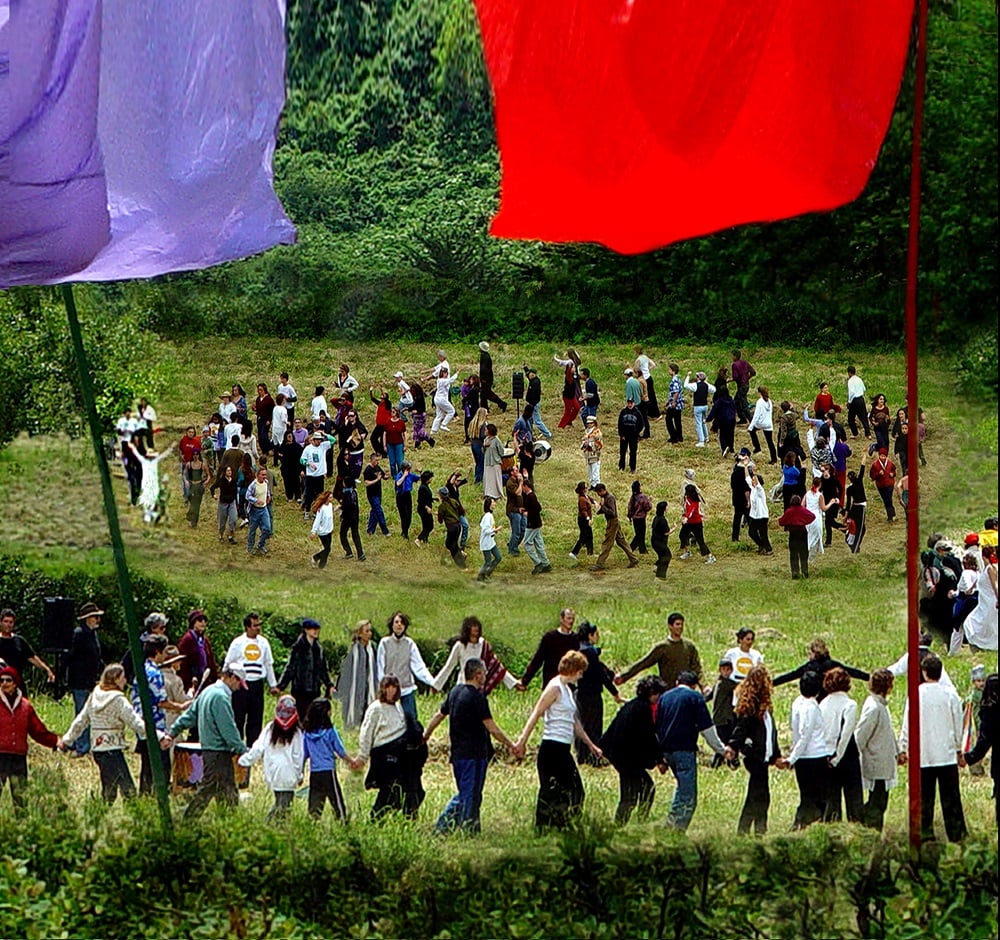
From pagan fertility rituals to extreme genital modification, it’s all here for the taking.

Hettie Judah

The world in 2017 is a frightening and chaotic place: why not relieve your anxiety with some casual masturbation or perhaps some good old-fashioned sex? As a corollary to the heavy menu of post-colonial guilt, migration-related tub-thumping and an abstract, queasy panic induced by global capitalism, this year’s Venice Biennale is letting off steam with an abundance of carnal knowledge. From pagan fertility rituals to extreme genital modification: it’s all here for the taking.
Showing as part of James Richards’s exhibition for the Welsh pavilion, the film What Weakens the Flesh Is the Flesh Itself (a collaboration with Steve Reinke) explores the body as a work of art in itself. Besides a lingering tour through snapshots of cheerful young men hanging out at a festival, and footage from an erotic photo-shoot heavy on the squashed fruit, the film draws extensively on the private photographic archive of Albrecht Becker.
An actor and photographer arrested and imprisoned for homosexuality by the Nazis, Becker became obsessed with representation and modification of the body. Gradually the images shown of this mild-looking elderly man in his V-necked sweaters become more unconventional, revealing a body entirely covered in homemade tattoos and piercings. Fairly close to the top of Venice’s wince list this year comes Becker’s modified and elephantine groin, so swollen that the penis prods out like a little mushroom cap. From a bolt through his glans, he lifts great metal chains.
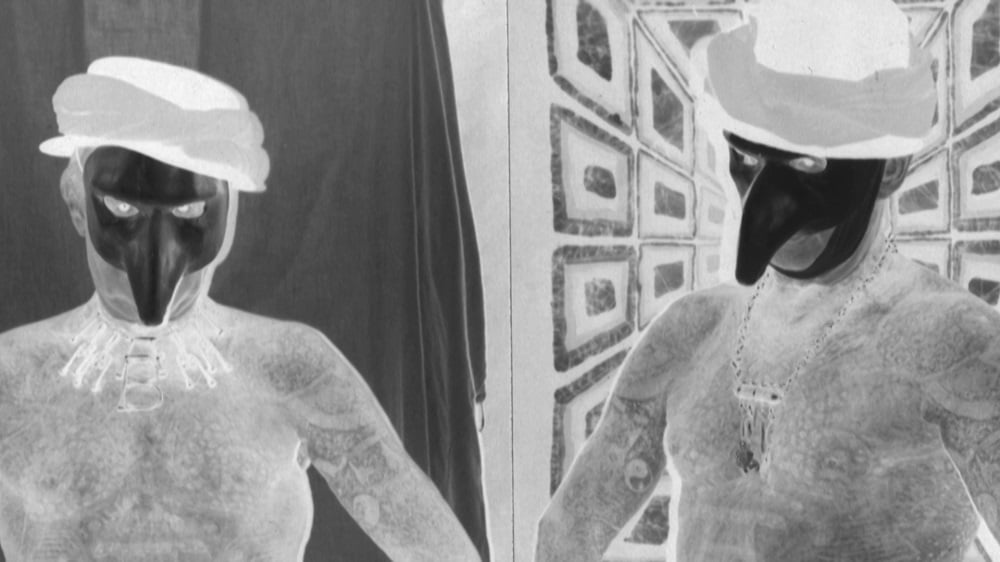
James Richards and Steve Reinke, What Weakens the Flesh Is the Flesh Itself, (still), 2017. Copyright James Richards and Steve Reinke; courtesy Wales in Venice.
An aura of masturbatory ennui pervades Anne Imhof’s Faust, though arnet News have yet to confirm eyewitness sightings of any actual, uh, finger painting, from those who have managed to fight their way into the German pavilion. And amid a general welter of pre- and post-apocalyptic fucking, both human and monkey, in Shezad Dawood’s Leviathan cycle, the narrator Yasmine masturbates next to the corpse of a woman whose jeans she’s about to purloin.
Meanwhile, in Spite Your Face—Rachel Maclean’s foray into post-truth Pinocchio territory at the pavilion of Scotland—the Trump-esque anti-hero Pic gets a memorable “nose job” from the Blue Fairy (an act made all the odder by the fact Maclean plays both characters.)
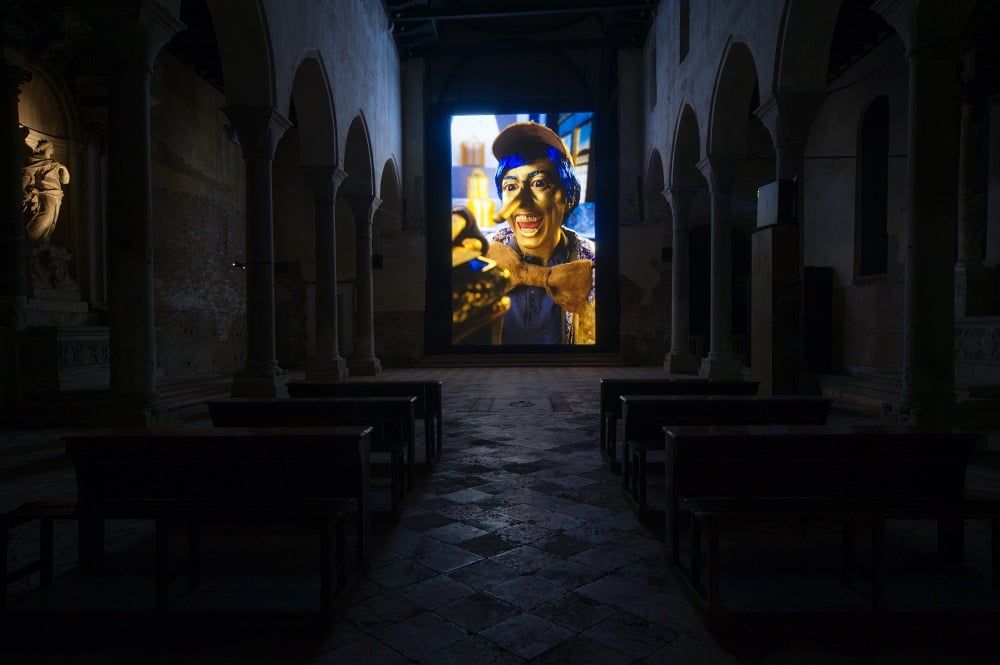
Rachel Maclean, Spite Your Face, (2017),(still). Courtesy the artist. Commissioned by Alchemy Film & Arts in partnership with Talbot Rice Gallery and the University of Edinburgh on behalf of Scotland + Venice.
At its most benign and jubilant, the theme of sexual reawakening at this Biennale corresponds to an overarching Haight-Ashbury atmosphere in the central “Viva Arte Viva” exhibition. There are “trans-pavilions” dedicated to such switched-on delights as Earth, Commons, and Shamanism. At the Dionysian pavilion—a section celebrating the joys of the female body and intoxication—progressive, liberated sexuality is explicitly a counterpart to the wider exhibition’s woke socio-political instincts.
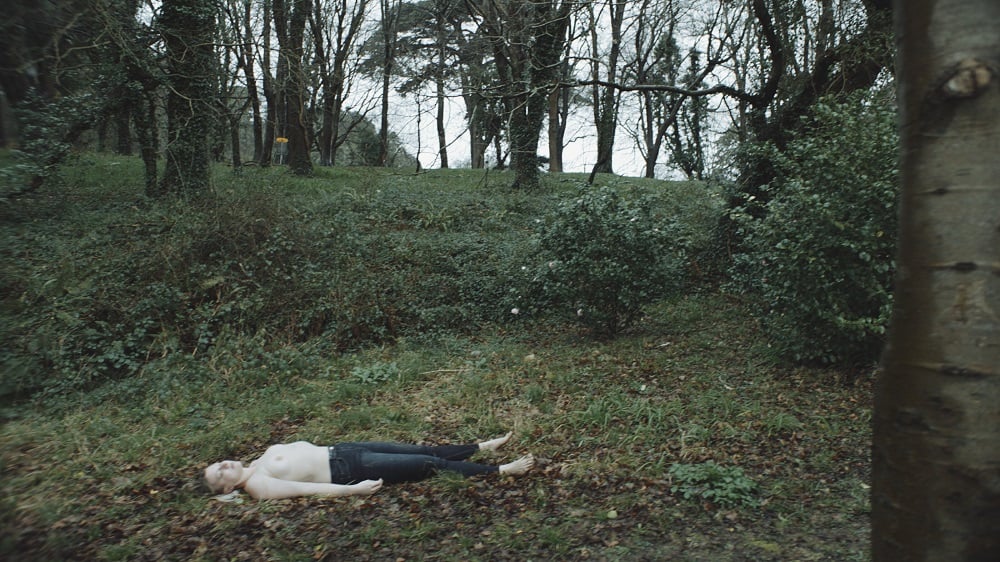
Shezad Dawood, Leviathan Cycle, Episode 2: Yasmine (production still) (2017). Courtesy of the artist and UBIK Productions
Huguette Caland’s erotic line drawings feature flesh-on-flesh frisson happening every-which-way. Three sweetly sexy interpretations of the ubiquitous Lebanese abaya are embroidered with details of naked and clinching bodies.
Here, too, are Heidi Bucher’s latex-sodden undergarments—some arranged in painting-like tableaus, others presented simply, as very frilly rubber knickers—that treat such intimate apparel like ancient artifacts to be pored over for their mysteries.
Pauline Curnier Jardin’s film and installation work Grotta Profunda Approfundita (for this critic, a highlight of the Biennale overall) places its viewers inside the human body, seated on a tufted rug that suggests the wall of a sexual organ. Among the many indelible images on offer is a louche Jesus, oiled and lounging in his loincloth like a 1970s tennis player, tempting a young Saint Bernadette with proclamations of love that sound divine in all the wrong ways. Oh, the ecstasies she suffers! Besides such holy visions, Curnier Jardin makes overt homage to the heavy-bodied and lysergic feminist film works of the 1960s and ’70s, which in themselves offer an essential intersection between sexual, and liberal/activist agendas.
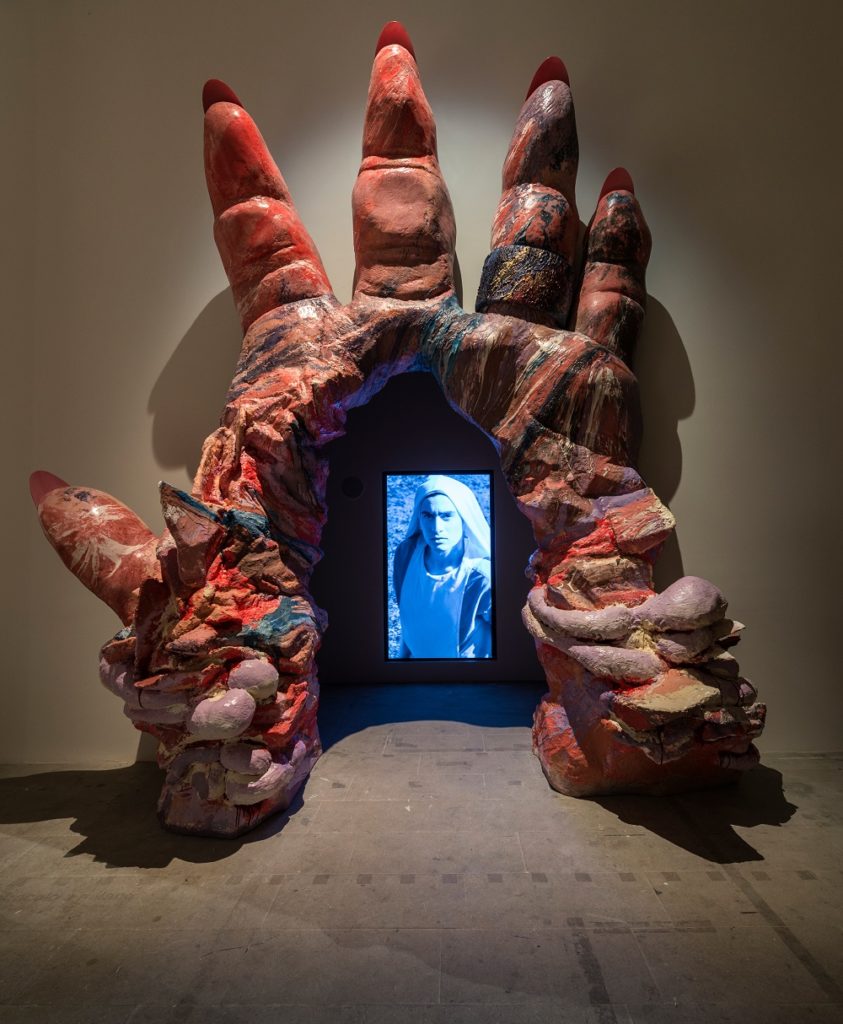
Pauline Curnier Jardin, Grotta Profunda, Approfundita, (2011-2017). Photo: Andrea Avezzù, Courtesy: La Biennale di Venezia
Anna Halprin’s annual Planetary Dance (1981-) is a community action and culturally hybrid ritual that revels in the natural world as a sacred space, and asserts women’s right to be free from sexual violence (the work commenced as an act of cleansing to “reclaim” a mountain near San Francisco on which a number of women had been murdered). This and other community actions—including Bonnie Ora Sherk’s urban farm projects from the 1970s and ‘80s—are an interesting reminder of the lack of hierarchy that existed between the practices of art-making and, say, urban gardening, only 30 years ago.
The will to retake power, and commitment to long-term grass-roots community action of these works from the 1970s and ‘80s feels quite distinct from the socio-political gestures of many contemporary works treading similar territory. In Les Immobiles, Marie Viognier shows a big-game hunter leafing through documentation of his glory days of shooting wild (and now endangered) animals in Africa, assisted by a cohort of black servants, as if his earlier self was, in turn, reliving the “glory” days of Empire. The film is a guaranteed feel-bad hit, destined to provoke paroxysms of guilt.
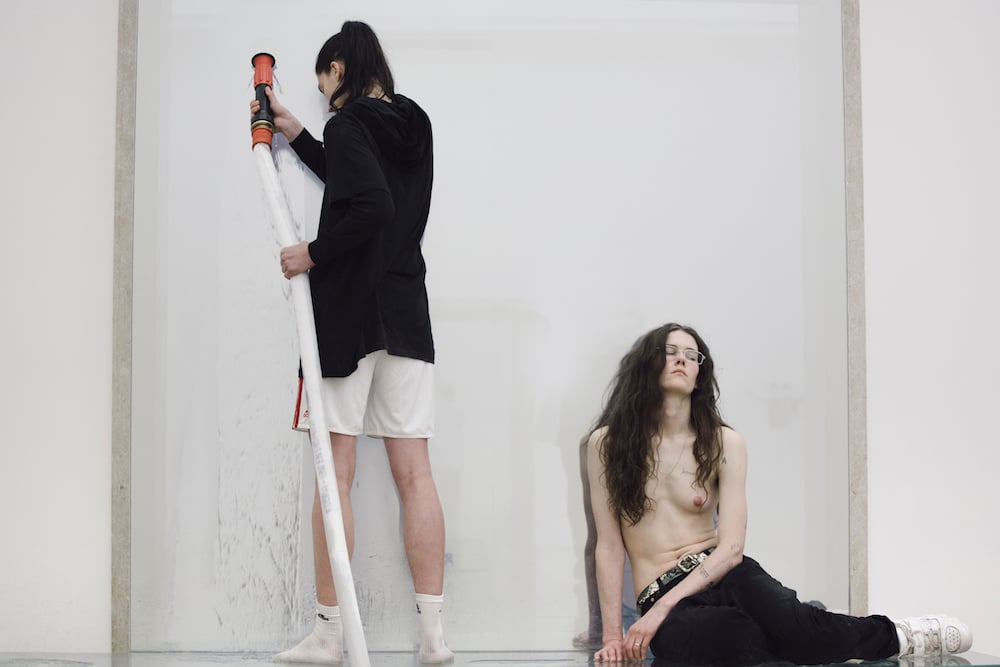
Eliza Douglas and Franziska Aigner in Anne Imhof’s Faust (2017).German Pavilion, 57th International Art Exhibition – La Biennale di Venezia ©Photo Nadine Fraczkowski, courtesy: German Pavilion 2017 and the artist.
At the pavilion of South Africa, Candice Breitz’s Love Story shows the actors Alec Baldwin and Julianne Moore performing excerpts from six filmed interviews with individuals that have fled their home countries. Extended (though not unedited) versions of each original interview can be seen in an adjacent gallery. The implication is that—heartless and superficial creatures that we are—we will sit rapt before the footage of Baldwin and Moore emoting wildly as they deliver their second-hand stories, while at the same time we give short shrift to the “real” tellers. The work positions us as patsies, set up for a fall.
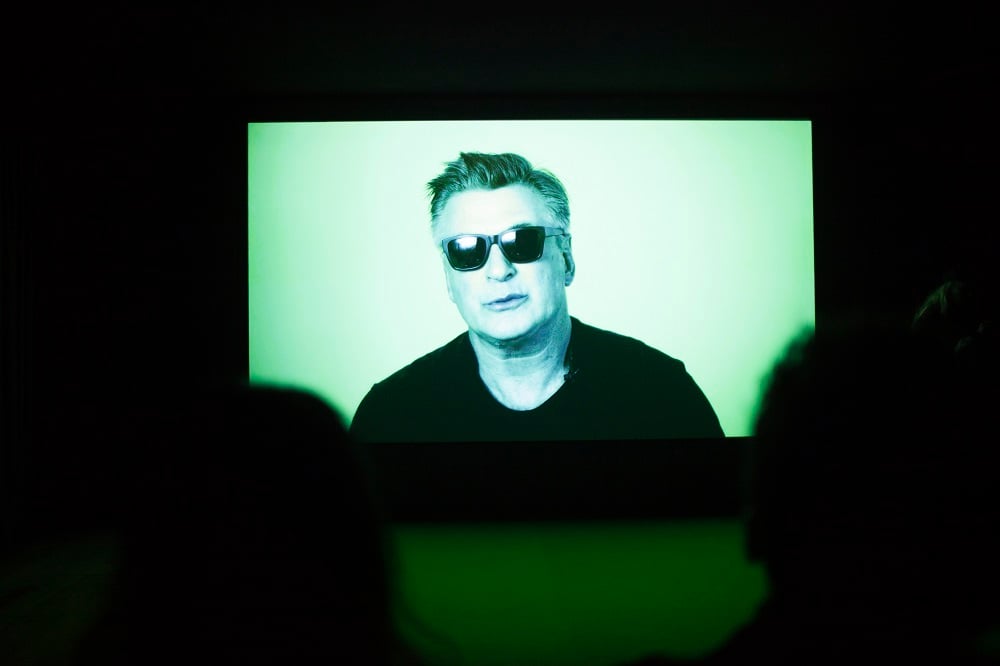
Candice Breitz, “Love Story” at the Pavilion of South Africa. Photo: Italo Rondinella. Courtesy: La Biennale di Venezia
In his opening address to the NSK State Pavilion, political philosopher and cultural critic Slavoj Žižek noted the compulsion to self-flagellate that accompanies art events such as Manifesta and the Venice Biennale. He located the roots of this compulsion in the art world’s distaste for its increasing integration into the global capitalist system.
Certainly the tendency toward artist as documentarian—with its suggestion of forcing encounters with uncomfortable truths—is one among many tendencies at Venice this year that arguably spring from and invigorate a compulsion to liberal guilt. The distraction of spicy fantasy is understandable.